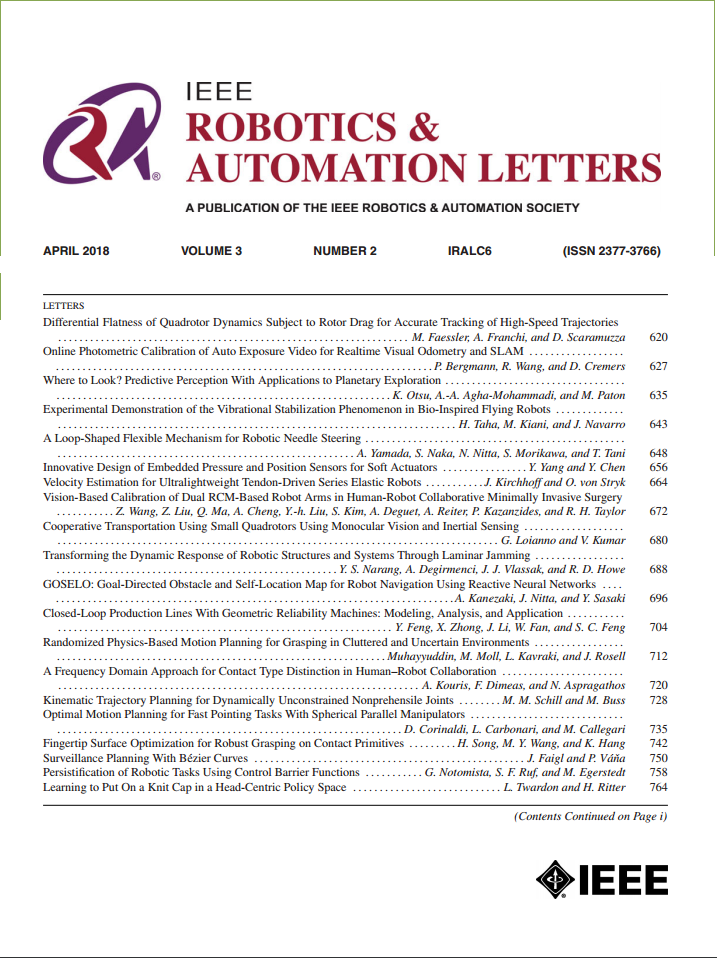3-Axis Angular Strain Estimation With Hall Effect Sensors for Proprioception of Soft Robotic Manipulators
IF 4.6
2区 计算机科学
Q2 ROBOTICS
引用次数: 0
Abstract
Slender soft robots offer significant advantages for real-life applications, particularly in areas that require delicate and adaptable interaction with complex environments. However, their effectiveness and safety can be greatly limited in the absence of sensing capabilities. Hall effect sensors, known for their excellent sensitivity and compact design, offer an innovative solution for equipping soft manipulators with perceptive abilities. In this letter, we propose an optimized sensor-magnet arrangement that can estimate all 3 angular strains of a slender rod, including torsion and bending along orthogonal axes, using a single sensor-magnet pair. With optimized design and experimental data, we trained a neural network to accurately predict angular strains from the measured magnetic fields. Using the predicted strains at different points along the body, we reconstruct the 3D shape of the sensorized manipulator using a Piece-wise Constant Angular Strain (PCAS) model. Two manipulator designs were considered in this work: single-segment and three-segment. Experimental results indicate tip position errors of less than 2% of the total manipulator length for the single-segment soft robot and less than 5% for the three-segment soft robot. The inherent simplicity of our design enables easy scaling and replication while ensuring reliable strain measurements critical for accurate robot shape reconstruction.基于霍尔效应传感器的柔性机械臂本体感觉三轴角应变估计
细长的软体机器人为现实生活中的应用提供了显著的优势,特别是在需要与复杂环境进行精细和适应性交互的领域。然而,如果没有感应能力,它们的有效性和安全性会受到很大限制。霍尔效应传感器以其卓越的灵敏度和紧凑的设计而闻名,为装备具有感知能力的软操纵器提供了创新的解决方案。在这封信中,我们提出了一种优化的传感器-磁铁排列,可以使用单个传感器-磁铁对估计细长杆的所有3个角应变,包括沿正交轴的扭转和弯曲。利用优化的设计和实验数据,我们训练了一个神经网络来准确地预测测量磁场的角应变。利用预测的沿体不同位置的应变,采用逐片恒角应变(PCAS)模型重构了传感机械臂的三维形状。本文考虑了单节段和三节段两种机械手设计。实验结果表明,单节软机器人的末端位置误差小于机械手总长度的2%,三节软机器人的末端位置误差小于5%。我们设计的固有简单性使缩放和复制变得容易,同时确保可靠的应变测量,这对于精确的机器人形状重建至关重要。
本文章由计算机程序翻译,如有差异,请以英文原文为准。
求助全文
约1分钟内获得全文
求助全文
来源期刊

IEEE Robotics and Automation Letters
Computer Science-Computer Science Applications
CiteScore
9.60
自引率
15.40%
发文量
1428
期刊介绍:
The scope of this journal is to publish peer-reviewed articles that provide a timely and concise account of innovative research ideas and application results, reporting significant theoretical findings and application case studies in areas of robotics and automation.
 求助内容:
求助内容: 应助结果提醒方式:
应助结果提醒方式:


